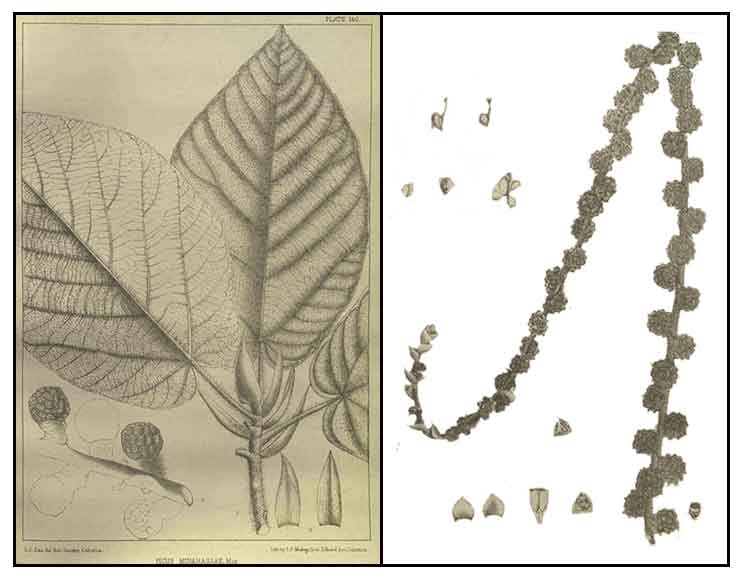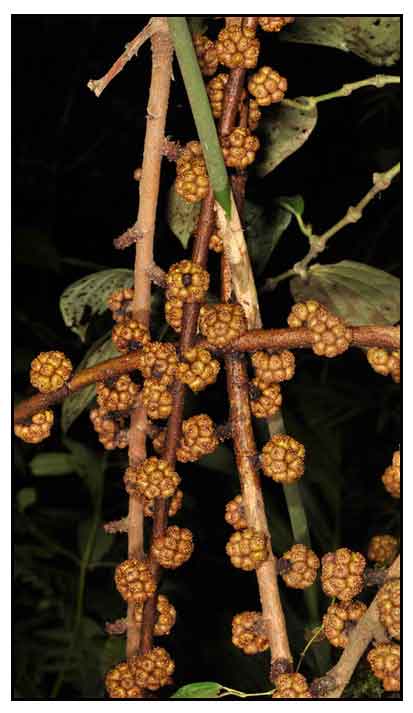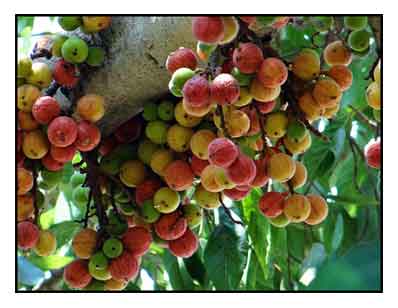
Family •Moraceae
Hagimit
Ficus minahassae (Teijsm. & Vriese) Miq.
CLUSTER FIG TREE
| Scientific names | Common names |
| Bosscheria minahassae de Vriese & Teijsm. | Agimet (Ilk.) |
| Ficus glomerata Blanco | Alomit (Ig.) |
| Ficus minahassae (Teijsm. & Vriese) Miq. | Arimit (Abra) |
| Arinit (Ting.) | |
| Ayimit (Tag.) | |
| Aymit (Ayta) | |
| Ayumit (Tag.) | |
| Businag (Ilk.) | |
| Gimit (Sub.) | |
| Hagamit (Tag.) | |
| Haganit (Tag.) | |
| Hagimit (Tag., Bis.) | |
| Hagumit (Tag.) | |
| Hasimit (C. Bis.) | |
| Lagumit (Buk.) | |
| Logemit (Higaonon) | |
| Malatungbog (Mbo.) | |
| Matanug (Sul.) | |
| Sabfog (Cordillera) | |
| Sangai (Bag.) | |
| Taisan (Yak.) | |
| Tam-isan (Bis.) | |
| Tambis-tambis (C. Bis.) | |
| Tambuyogan (S. L. Bis.) | |
| Cluster fig tree (Engl.) | |
| Ficus minahassae (Teijsm. & Vriese) Miq. is an accepted species. KEW: Plants of the World Online | |
| Other vernacular names |
| INDONESIAN: Langusei. |

Updated August 2024 / May 2020 / October 2016
![]()
 |
| Â Â Â Â Â Â Â Â Â Â Â Â Â Â Â Â Â Â Â Â Â Â Â Â Â PHOTOS / ILLUSTRATIONS |
| IMAGE SOURCE: / Illustration / Ficus minahassae (Teijsm. & Vriese) Miq. / Annals of the Royal Botanic Garden, Calcutta, vol. 1: t. 141 (1888) [G.C. Das] / Illustration contributed by the Library of the Missouri Botanical Garden, U.S.A. / Plant Illustration / CLICK ON IMAGE TO GO TO SOURCE PAGE |
| OTHER IMAGE SOURCE:/ Photograph / Moraceae : Ficus minahassae det. John Rey Callado 26-Nov-11 / Infructescence Copyright © 2012 by P.B. Pelser & J.F. Barcelona (contact: pieter.pelser@canterbury.ac.nz) [ref. DOL46340] / PhytoImages.siu.edu |
| OTHER IMAGE SOURCE:/ Photograph / Fruit clusters : Ficus minahassae / Cluster fig tree / Click on image to go to source page / Copyright / © earth.com |
| OTHER IMAGE SOURCE: Ficus minahassae / Leaf / © Uluulublog / Non-commercial use / Image modified / Click on image or link to go to source page / The Figs of Borneo |
Additional
Sources and Suggested Readings |
• |
DOI: It is not uncommon for links on studies/sources to change. Copying and pasting the information on the search window or using the DOI (if available) will often redirect to the new link page. (Citing and Using a (DOI) Digital Object Identifier) |
| Â Â Â Â Â Â Â Â Â Â Â Â Â Â Â Â Â Â Â Â Â Â Â Â Â Â Â Â Â Â List of Understudied Philippine Medicinal Plants |
| Â Â Â Â Â Â Â Â Â Â Â Â Â Â Â Â Â Â Â Â Â New plant names needed The compilation now numbers over 1,500 medicinal plants. While I believe there are hundreds more that can be added to the collection, they are becoming more difficult to find. If you have a plant to suggest for inclusion, native or introduced, please email the info: scientific name (most helpful), local plant name (if known), any known folkloric medicinal use, and, if possible, a photo. Your help will be greatly appreciated. |
• |
 |


 Constituents
Constituents Folkloric
Folkloric